Monet. Degas. Warhol. Ancient, Asian, and African art spanning millennia. With more than 100,000 items in its collections crossing eras and genres, the Princeton University Art Museum is considered one of the finest academic art museums in the country. It adds hundreds of works each year through purchases, gifts, and bequests (primarily from alumni and faculty), and employs 11 full-time curators to oversee its collections. Acting as buyers, researchers, historians, and often teachers, curators have an intimate understanding of the works they purchase, study, and assign for display. PAW asked them to highlight some of their favorite works, selected from the more than 4,500 items on public view in the museum and around campus.
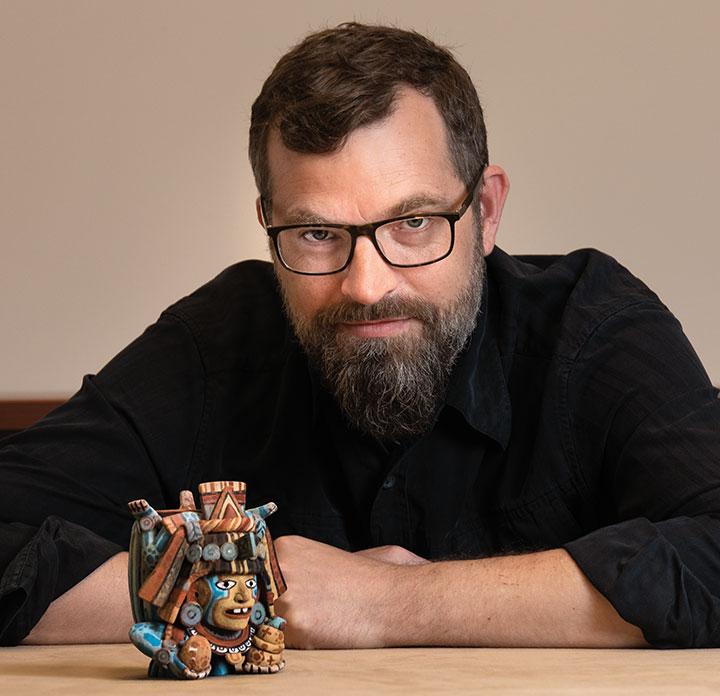
Lidded effigy container in the form of a diving god
ca. 1500, ceramic with post-fire polychrome paint
BRYAN JUST, Peter Jay Sharp, Class of 1952, Curator and Lecturer in the Art of the Ancient Americas
This Maya artifact is “eclectic,” says Just, “and there are aspects of it which are not very Maya.” He should know — Just began studying art history during a revolution in the study of Maya art that used new knowledge of hieroglyphs to classify and understand the works, a development that enticed him to make Maya art his specialty. Although his purview at the museum includes all ancient American art (defined as works produced before European contact), Maya works hold a special place in his heart.
This effigy, a representation of the Maya maize god, captures the interconnectedness of Mesoamerican cultures on the eve of European contact. In addition to having “especially exceptional” preserved coloring, Just says, the blue lines coming down the face and around the mouth are typical of Central Mexican and Aztec culture. “In a way, this is really a combination of Maya concepts and Maya religious practice — things like tamales, which are local — with something we consider an international style,” he notes. Other quirks, like the blue head of an ocellated turkey above the tamale dough held in the god’s left hand and the “diving” orientation of the figure, make it a valuable object for teaching as well as an eye-popping piece in the gallery.

Blue Marilyn
Andy Warhol, 1962, acrylic and screen print ink on canvas
MITRA ABBASPOUR, Haskell Curator of Modern and Contemporary Art
When Abbaspour first saw this piece, one of the most recognizable in the museum’s collections, she was engaged by more than its bright colors. “I was immediately taken with the fact that it had this very interesting provenance,” she says. The work was a gift of Alfred H. Barr Jr. ’22 *24, the founding director of the Museum of Modern Art (Abbaspour’s former employer), who bought it following Warhol’s first solo exhibition in New York. “From the moment it was created, exhibited, and purchased,” Abbaspour says, the work was “anchored in a network and a set of figures who established American modernism.” This connection is part of what Abbaspour appreciates about art: “Art carries with it a lot of information about the economy, about history, about culture.” Bringing together Princeton, Barr, and Warhol, not to mention Marilyn Monroe, Abbaspour identifies the piece as a “bridge” — a description that also extends to the work’s composition. “It’s simultaneously a photograph, a print, and a painting,” says Abbaspour, who highlights the visible texture of the silkscreen used to transfer the high-contrast photo of Monroe to the canvas after Warhol painted it with acrylic paint. The artificial colors layered onto the photo can also be seen as a reflection on Monroe’s legacy. The painting was first displayed only months after the actress, known for her façade of glamour, committed suicide at 36.
“From the moment it was created, exhibited, and purchased,” the work was “anchored in a network and a set of figures who established American modernism.”
Mitra Abbaspour
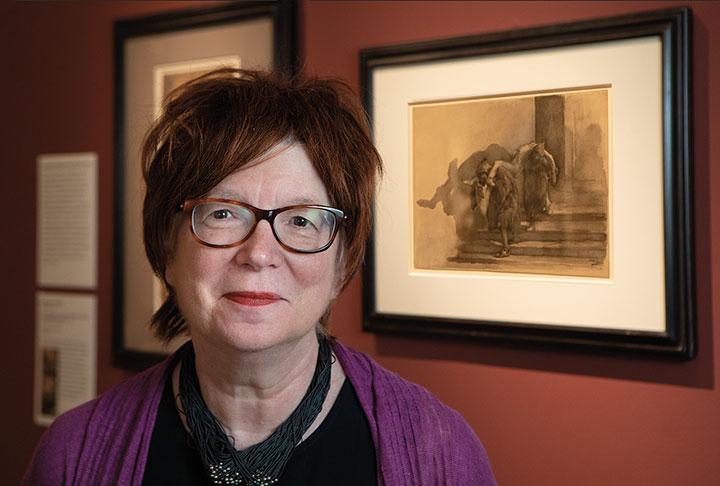
The Monatti, Illustration to Alessandro Manzoni’s I Promessi Sposi
Gaetano Previati, ca. 1895-99, watercolor, heightened with white gouache, on light brown wove paper
LAURA GILES, Heather and Paul G. Haaga Jr., Class of 1970, Curator of Prints and Drawings
Giles’ focus has been on drawings, particularly Italian ones, since graduate school, when she wrote her dissertation on Giacomo Cavedone, a 17th-century Italian artist “that nobody’s heard of,” she jokes. That experience serves her well in her role at the museum, which has between 5,000 and 6,000 drawings, 1,000 of which are Italian.
This drawing was commissioned for a 1900 edition of the Italian novel I Promessi Sposi (The Betrothed), an epic tale of romance amid the bubonic plague in 17th-century Milan. It is one of more than 300 drawings that Previati created for the book, but is — as far as Giles can tell — the only drawing of his in America, where he is not well known. The chance to bring the illustration to the museum in 2007 was exciting for Giles, who says, “You see something like this and you tell the director, ‘This may not be an artist that people are familiar with, but it’s going to resonate across many different audiences.’”
Giles lauds Previati’s command of watercolor, and especially how he used only a few strategically placed brushstrokes to create the harrowing scene. She also highlights the abstract nature of the shadows cast by the corpse carriers. All of this was done without the assistance of an underdrawing.
“This may not be an artist that people are familiar with, but it’s going to resonate across many different audiences.”
Laura Giles
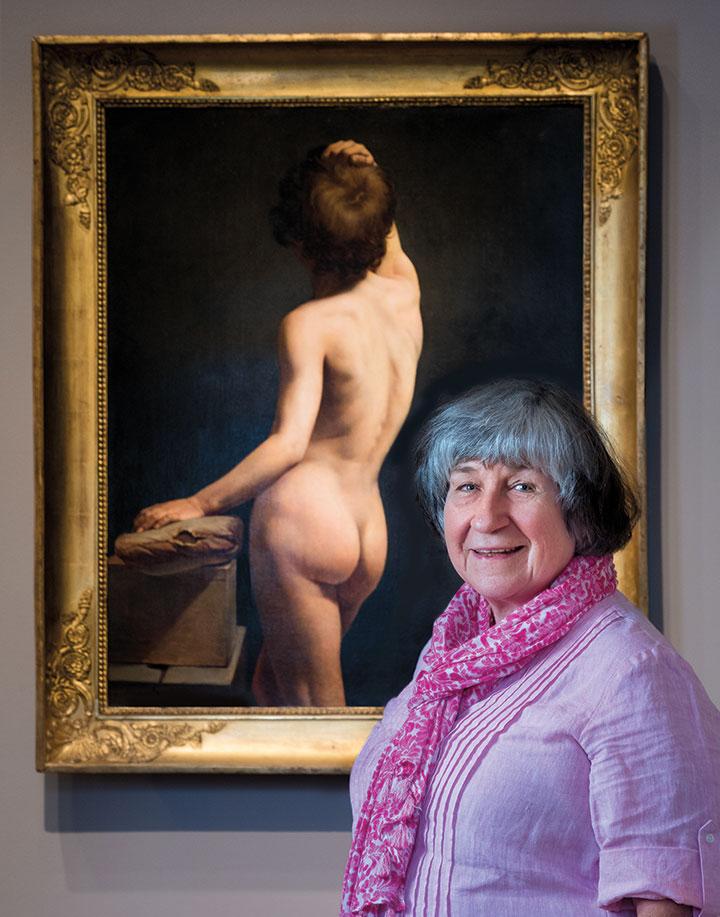
Academic Study of Adolescent Boy, Seen from Behind
Horace Vernet, ca. 1807–1810, oil on canvas
BETSY J. ROSASCO, Research Curator of European Painting and Sculpture
Rosasco first visited Europe at the “impressionable age” of 8, an experience that sparked a lifelong interest in European art and history. After working at the National Gallery of Art and Bryn Mawr College, she joined Princeton’s museum in 1981, where she has spent nearly 40 years researching and curating the work of European artists who worked between the late Middle Ages and the mid-20th century.
This Vernet painting is officially dated to between 1807 and 1810, when the painter would have been a student honing his technique at a Paris art school. However, Rosasco believes the painting is from later in the artist’s career because, she says, it breaks with the tradition of the academic study. “It’s always puzzled me,” she says. “It has homoerotic overtones. Usually academic studies would stop at the waist, and this one is a much longer view of the boy’s body, and he seems to be flaunting his nudity because of this.”
Moreover, the boy has dirty fingernails, which an academic artist would not have painted, she explains: “It’s supposed to be idealized Greco-Roman antiquity or religious scenes taken from the Bible.” These details, along with letters from Vernet that record his intent to “go back to the basics,” suggest to Rosasco that the painting is by “a mature artist going back and rethinking what the possibilities of this academic study genre were.” Discoveries like these are what Rosasco enjoys: “Living with a collection, you keep asking new questions, and puzzling over things you don’t understand — and pretty soon you start seeing things that give you new insights.”
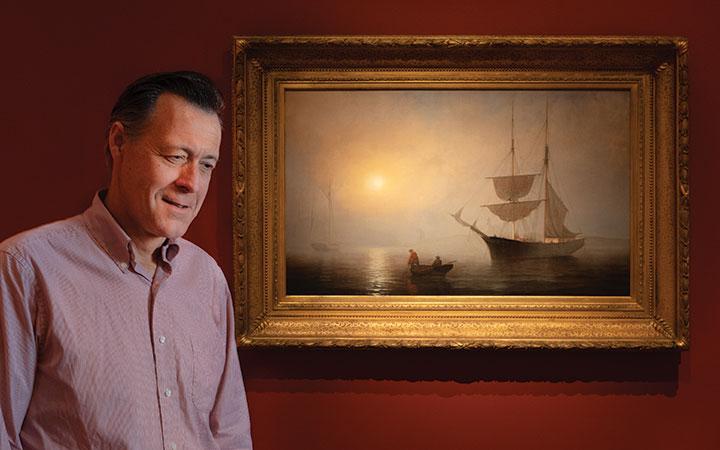
Ship in Fog, Gloucester Harbor
Fitz Henry Lane, ca. 1860, oil on canvas
KARL KUSSEROW, John Wilmerding Curator of American Art
“It’s sort of a dream acquisition for any curator in my field,” Kusserow says of this Lane painting. “It’s so evocative, and so subtle, and so masterful.” Although it came to the museum in 2015, “Ship in Fog” had been on Kusserow’s mind since 2005, when as a young curatorial assistant he found it in a catalog from the museum’s 1996 exhibition commemorating the University’s 250th anniversary.
Art Museum’s New Exhibition: A Three-Century Look at How Artists Shaped Our View of Nature
In the minority of paintings that Lane made in the Luminist mode, a Transcendentalist-inspired style, this painting is also one of the few that feature fog — “the hardest thing for a painter to portray,” Kusserow explains. It may also be a self-portrait of Lane, represented as the dark-clad figure intently watching the harbor from his Whitehall rowboat. “I love this painting,” says Kusserow, “and I think other people love it too. There used to be a bench right here — you’d sometimes walk through, and there’d be someone sitting here, just staring at it. It’s a painting you can really lose yourself in.”
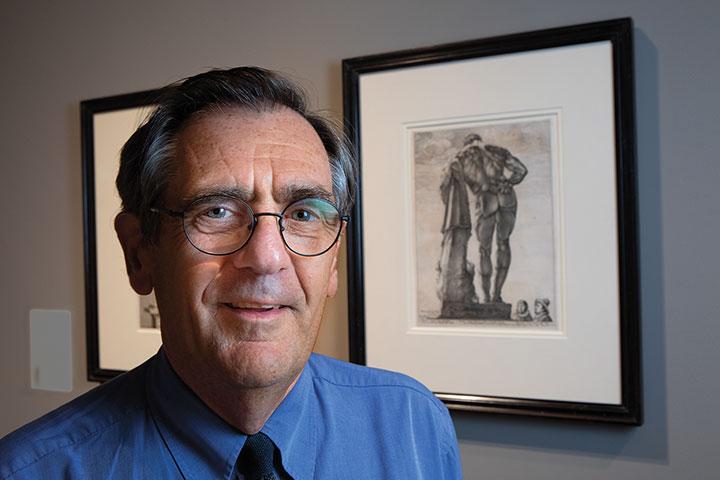
Hercules Farnese, Back View
Hendrick Goltzius, 1592, printed 1617, engraving
CALVIN BROWN, Associate Curator of Prints and Drawings
Brown calls Goltzius “the greatest engraver of all time,” and this print shows the marks of the Dutch artist’s expertise: shadow, depth, bulging muscles, and chiseled stone created through thin lines of ink on paper. In the 16th and 17th centuries, printmaking was the only way to distribute images widely, making the reproductions of famous sculptures and artworks by engravers such as Goltzius highly sought after. However, by portraying the rarely seen back of the Hercules Farnese sculpture, Goltzius was also trying to demonstrate his wit. “He’s a bit of a show-off,” says Brown.
Goltzius controlled both aspects of the printmaking process — the creation of the copper or wood plate and the actual printing of the image onto paper — a rarity among his contemporaries that made his prints exceptionally refined. Brown, himself a trained printmaker, praises the technique Goltzius exemplified in this print, including cross-hatching used “to get a glowing sort of light,” and moiré patterns (seen when repeating patterns overlap each other) that heighten the visual effect. Through fine technique, Brown says, Goltzius could “create majesty out of a black-and-white image.”
By portraying the back of the Hercules Farnese sculpture, Goltzius was also trying to demonstrate his wit. “He’s a bit of a show-off.”
Calvin Brown
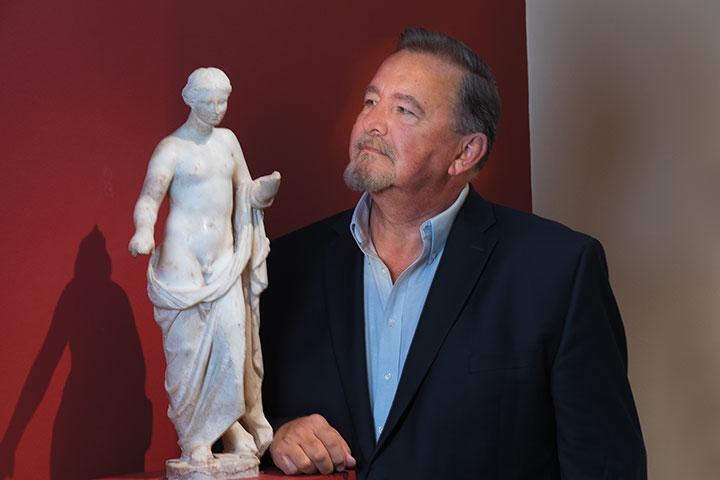
Statuette of Hermaphrodite
2nd century B.C., white marble
J. MICHAEL PADGETT, Curator of Ancient Art
A general interest in history turned specific for Padgett in his freshman year of college, when he read H.D.F. Kitto’s The Greeks and became fascinated by ancient Greek art and archaeology. After spending a few years in state government, he went to graduate school at Harvard to study art history. “I had come to realize that what made me the happiest was being in museums,” he says, “and that it would be best if I were paid for this.”
Padgett joined the museum staff in 1992 and oversaw the purchase of this statuette in 2009 — a Greek piece in an ancient statue collection that is more than 80 percent Roman. In Greek mythology, the god Hermaphroditus, the son of Hermes and Aphrodite, gained a dual male and female nature when his lover, the nymph Salmacis, prayed to the gods for the two never to be separated. The statuette was likely sculpted after an original model, and Padgett praises the sculptor’s smooth combination of the male and female figure, particularly in the torso and hips. “It’s subtle,” says Padgett. “The modeling of the body is quite well done.”
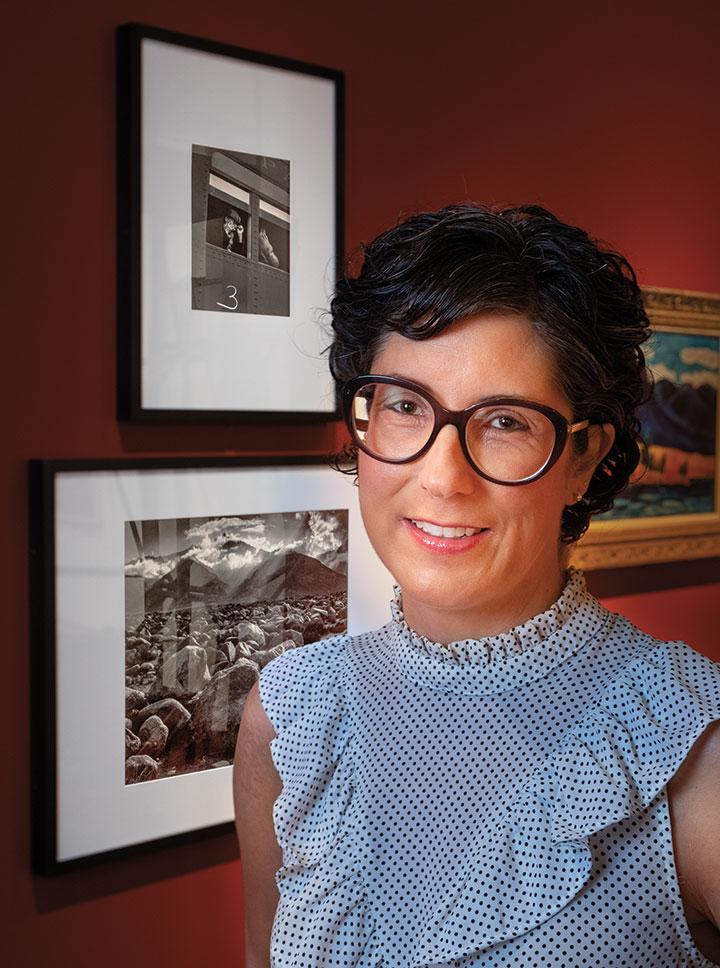
Ten cars of evacuees of Japanese ancestry are now aboard and the doors are closed. Evacuees are bound for Merced Assembly Center [Temporary Detention Center], California
Dorothea Lange, 1941, gelatin silver print
Mount Williamson, Sierra Nevada, from Manzanar, California
Ansel Adams, 1944, printed 1980, gelatin silver print
KATHERINE BUSSARD, Peter C. Bunnell Curator of Photography
Photography is a particular strength of the museum’s collections — photographs make up nearly half of the museum’s holdings — and the medium has an auspicious history at Princeton in general: The University was the first institution in the nation to have an endowed professorship in the history of photography. The museum continues to acquire notable photographs such as this one from Dorothea Lange, which Bussard says “stopped me in my tracks” when she saw it in a gallery earlier this year. The photo is one of many Lange took documenting the movement of Japanese Americans to detention camps during World War II, and Bussard notes its “captivating and harrowing” subject: the woman in the train car window. “For me it comes down to that very delicate and tender gesture of wiping away tears at leaving, presumably, her entire life behind,” Bussard says. She also points out what seems like a hastily drawn numeral “3” on the train car, which speaks to the haphazardness of the operation.
Bussard calls her placement of Lange’s photograph alongside an Ansel Adams landscape an attempt to “recontextualize” Adams’ image by putting the two photos in conversation. Adams took this picture at Manzanar, one of the 10 detention camps for Japanese Americans operated by the United States. The photographer had traveled to the camp after hearing of its conditions from Lange. “Instead of seeing this as a landscape of glory and manifest destiny and American wonder, all of a sudden you understand that he’s standing inside, effectively, prison grounds that were established out of racial hatred and fear,” says Bussard. “I think they do better work together than apart.”
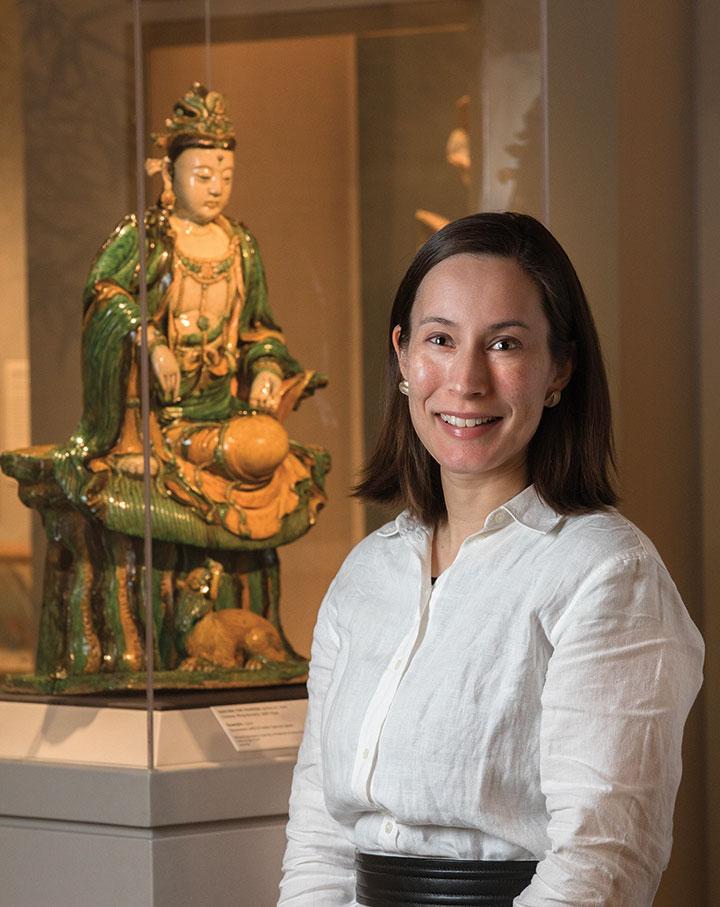
Guanyin
Qiao Bin (the younger), 1500, stoneware with sancai glaze
ZOE KWOK *13, Assistant Curator of Asian Art
When Kwok began studying art history as an undergrad, she thought she wanted to study European art. She knew Chinese, however, and after a year at the National Palace Museum in Taiwan, she came to Princeton for graduate school with a new focus — Chinese painting. She joined the museum as a curator in 2013.
This statue of Guanyin, a bodhisattva — a Buddhist who has achieved enlightenment but elected to stay on Earth — was likely meant for a Buddhist temple or shrine. Its sancai, or tri-color, glaze is a callback to works produced 700 years earlier, and the statue’s construction represents the height of Chinese artistic prowess. Admiring the piece, Kwok says, “The glaze is superb. The colors are spectacular. The green is remarkably rich, that amber brown is lustrous. ... It’s a superbly modeled ceramic sculpture.”
“Guanyin” is valuable for more than just its craftsmanship, however. “The really fascinating and very rare thing is that there’s an inscription on the back,” says Kwok. “In Chinese sculpture, it isn’t often you see anything like this.” The inscription identifies not only the artist, Qiao Bin, but also the patrons who supported his work, the location of his workshop, and the date the piece was produced. “This is an incredible historical document that is actually on the work of art,” Kwok says, and it makes the statue useful for teaching and research in addition to being a vibrant work to display.
Alden Hunt ’20 is an intern at PAW. He is majoring in electrical engineering.


